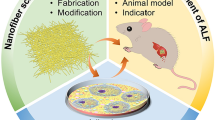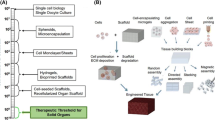Abstract
Purpose
The effectiveness of decellularization and recellularization of rabbit kidney scaffolds with autologous adipose-derived mesenchymal stem cells (ADMSCs) was assessed. The static-based technique was judged against the perfusion-based method both in decellularization and recellularization processes.
Methods
Kidneys were obtained from 8 rabbits and divided into two groups. Two kidneys did not undergo any processing and were served as the control group. Kidneys of group I (N = 7) were cannulated via the renal artery and decellularized with a detergent-based method. We reseeded these constructs with ADMSCs using a peristaltic pump. The static method was applied to decellularize and recellularize thin slices of the seven kidneys (group II, N = 7) using the L929 cell line. Several tests were performed to evaluate the efficacy of the decellularization and recellularization processes.
Results
All cellular and nuclear constituents were eliminated from the scaffolds of both groups confirmed with hematoxylin and eosin (H&E), trichrome, 4′,6-diamidino-2-phenylindole (DAPI) staining, and DNA quantification. Cell viability was over 89% as performed by MTT assay. Cells were effectively seeded in scaffolds of both groups, with a superior arrangement and a higher concentration in the perfusion-based technique. Immunohistochemistry (IHC) staining demonstrated preservation of native expression patterns of extracellular matrix proteins with better results in perfusion-based technique.
Conclusion
The results suggest that organs with the distributed micro-vasculature system (perfusion method) may benefit from being engineered with the dynamic procedure compared with organs with empty chambers and poor vasculature system (static system).
Lay Summary
Previously, we evaluated the efficacy of the transplantation of decellularized kidneys in a rat model. In this study, we try to assess the efficacy of two decellularization and recellularization protocols of kidney organs for further renal tissue engineering. We also aim to produce renal scaffolds with structural, mechanical, and physiological characteristics that are crucial for engineering main renal structures, using adipose-derived mesenchymal stem cells.
Future Studies
Finding the most suitable and feasible decellularization and recellularization methods is important in several medicinal therapeutics. In the future, we will emphasize on the long-term viability and functionality of obtained kidney scaffolds in clinically translatable applications. We will also compare different cell lineages to obtain the most efficient scaffold for further renal tissue engineering.






Similar content being viewed by others
Change history
14 June 2021
A Correction to this paper has been published: https://doi.org/10.1007/s40883-021-00214-1
References
Sullivan DC, Mirmalek-Sani S-H, Deegan DB, Baptista PM, Aboushwareb T, Atala A, et al. Decellularization methods of porcine kidneys for whole organ engineering using a high-throughput system. Biomaterials. 2012;33(31):7756–64.
Saran R, Robinson B, Abbott KC, Agodoa LY, Albertus P, Ayanian J, et al. US renal data system 2016 annual data report: epidemiology of kidney disease in the United States. Am J Kidney Dis. 2017;69(3):A7–8.
Song JJ, Guyette JP, Gilpin SE, Gonzalez G, Vacanti JP, Ott HC. Regeneration and experimental orthotopic transplantation of a bioengineered kidney. Nat Med. 2013;19(5):646–51. https://doi.org/10.1038/nm.3154.
Crapo PM, Gilbert TW, Badylak SF. An overview of tissue and whole organ decellularization processes. Biomaterials. 2011;32(12):3233–43.
Figliuzzi, M., Remuzzi, G. and Remuzzi, A. Recellularization of kidney scaffold with stem cells. In: Kidney transplantation, bioengineering and regeneration. Academic Press. 2017;877–86.
Presnell SC, Bruce AT, Wallace SM, Choudhury S, Genheimer CW, Cox B, et al. Isolation, characterization, and expansion methods for defined primary renal cell populations from rodent, canine, and human normal and diseased kidneys. Tissue Eng Part C Methods. 2010;17(3):261–73.
Aboushwareb T, Egydio F, Straker L, Gyabaah K, Atala A, Yoo JJ. Erythropoietin producing cells for potential cell therapy. World J Urol. 2008;26(4):295–300.
Wrighton PJ, Kiessling LL. Forces of change: mechanics underlying formation of functional 3D organ buds. Cell Stem Cell. 2015;16(5):453–4.
Sabetkish S, Kajbafzadeh AM, Sabetkish N, Khorramirouz R, Akbarzadeh A, Seyedian SL, et al. Whole-organ tissue engineering: decellularization and recellularization of three-dimensional matrix liver scaffolds. J Biomed Mater Res A. 2015;103(4):1498–508.
Guruswamy Damodaran R, Vermette P. Tissue and organ decellularization in regenerative medicine. Biotechnol Prog. 2018;34(6):1494–505.
Hillebrandt KH, Everwien H, Haep N, Keshi E, Pratschke J, Sauer IM. Strategies based on organ decellularization and recellularization. Transpl Int. 2019;32(6):571–85.
Tajima K, Kuroda K, Otaka Y, Kinoshita R, Kita M, Oyamada T, et al. Decellularization of canine kidney for three-dimensional organ regeneration. Vet World. 2020;13(3):452–7.
Chow T, Whiteley J. and Rogers I.M. Decellularizing and recellularizing adult mouse kidneys. Methods Mol Biol. 2019;1926:169–84.
Zambon JP, Ko IK, Abolbashari M, Huling J, Clouse C, Kim TH, et al. Comparative analysis of two porcine kidney decellularization methods for maintenance of functional vascular architectures. Acta Biomater. 2018;75:226–34.
Fischer I, Westphal M, Rossbach B, Bethke N, Hariharan K, Ullah I, et al. Comparative characterization of decellularized renal scaffolds for tissue engineering. Biomed Mater. 2017;12(4):045005.
Ross EA, Williams MJ, Hamazaki T, Terada N, Clapp WL, Adin C, et al. Embryonic stem cells proliferate and differentiate when seeded into kidney scaffolds. J Am Soc Nephrol. 2009;20(11):2338–47.
Xue A, Niu G, Chen Y, Li K, Xiao Z, Luan Y, et al. Recellularization of well-preserved decellularized kidney scaffold using adipose tissue-derived stem cells. J Biomed Mater Res A. 2018;106(3):805–14.
Kim I-H, Ko IK, Atala A, Yoo JJ. Whole kidney engineering for clinical translation. Curr Opin Organ Transplant. 2015;20(2):165–70.
Baptista PM, Siddiqui MM, Lozier G, Rodriguez SR, Atala A, Soker S. The use of whole organ decellularization for the generation of a vascularized liver organoid. Hepatology. 2011;53(2):604–17.
Ott HC, Clippinger B, Conrad C, Schuetz C, Pomerantseva I, Ikonomou L, et al. Regeneration and orthotopic transplantation of a bioartificial lung. Nat Med. 2010;16(8):927–33.
Hachisuka S, Sato Y, Yoshiike M, Nakazawa R, Sasaki H, Chikaraishi T. Enhanced recellularization of renal extracellular matrix scaffold under negative pressure. Integr Mol Med. 2015;2(6):394–9.
Bonandrini B, Figliuzzi M, Papadimou E, Morigi M, Perico N, Casiraghi F, et al. Recellularization of well-preserved acellular kidney scaffold using embryonic stem cells. Tissue Eng A. 2014;20(9–10):1486–98.
Kajbafzadeh A-M, Khorramirouz R, Kameli SM, Nabavizadeh B. Microsurgical anastomosis of renal vasculature in rats: a practical platform for acellular kidney transplantation. J Pediatr Urol. 2018;14(2):194–5.
Osele C, Bonandrini B, Manuela D, Conti S, Rizzo P, Valentina B, et al. Engineering the vasculature of decellularized rat kidney scaffolds using human induced pluripotent stem cell-derived endothelial cells. Sci Rep (Nature Publisher Group). 2019;9(1):8001.
Ko IK, Abolbashari M, Huling J, Kim C, Mirmalek-Sani S-H, Moradi M, et al. Enhanced re-endothelialization of acellular kidney scaffolds for whole organ engineering via antibody conjugation of vasculatures. Technology. 2014;2(03):243–53.
Guan Y, Liu S, Sun C, Cheng G, Kong F, Luan Y, et al. The effective bioengineering method of implantation decellularized renal extracellular matrix scaffolds. Oncotarget. 2015;6(34):36126–38.
Peloso A, Ferrario J, Maiga B, Benzoni I, Bianco C, Citro A, et al. Creation and implantation of acellular rat renal ECM-based scaffolds. Organogenesis. 2015;11(2):58–74.
Remuzzi A, Figliuzzi M, Bonandrini B, Silvani S, Azzollini N, Nossa R, et al. Experimental evaluation of kidney regeneration by organ scaffold recellularization. Sci Rep. 2017;7:43502.
Kajbafzadeh A, Sabetkish N, Sabetkish S, Tavangar S, Beigi RH, Talebi M, et al. Lung tissue engineering and preservation of alveolar microstructure using a novel casting method. Biotech Histochem. 2015;90(2):111–23.
Kajbafzadeh A-M, Khorramirouz R, Nabavizadeh B, Seyedian S-SL, Akbarzadeh A, Heidari R, et al. Whole organ sheep kidney tissue engineering and in vivo transplantation: effects of perfusion-based decellularization on vascular integrity. Mater Sci Eng C. 2019;98:392–400.
Funding
The authors thank the Tehran University of Medical Sciences for funding this study (Grant Number 32213).
Author information
Authors and Affiliations
Corresponding author
Ethics declarations
Conflict of Interest
The authors declare that they have no conflict of interest.
Ethical Approval
All procedures performed in this study were in accordance with the ethical standards and under guidelines approved by the local ethical committee of the Tehran University of Medical Sciences. The animal experiment complies with the National Institutes of Health guide for the care and use of laboratory animals (NIH Publications No. 8023, revised 1978).
Additional information
Publisher’s Note
Springer Nature remains neutral with regard to jurisdictional claims in published maps and institutional affiliations.
Rights and permissions
About this article
Cite this article
Sabetkish, S., Sabetkish, N., Ekhtiari, M. et al. Decellularization and Recellularization of Rabbit Kidney Using Adipose-Derived Mesenchymal Stem Cells for Renal Tissue Engineering. Regen. Eng. Transl. Med. 6, 433–441 (2020). https://doi.org/10.1007/s40883-020-00177-9
Received:
Revised:
Accepted:
Published:
Issue Date:
DOI: https://doi.org/10.1007/s40883-020-00177-9




